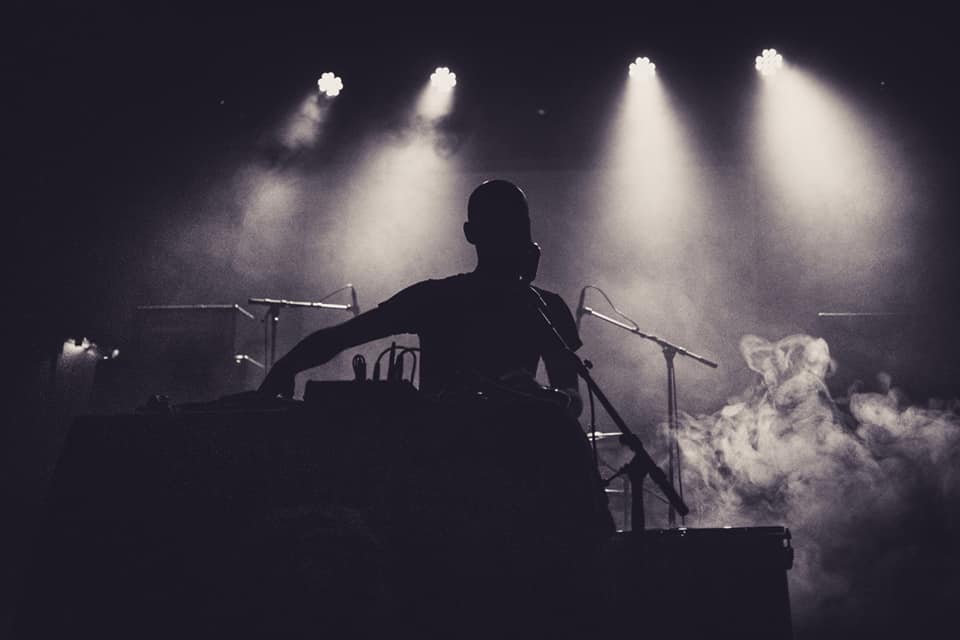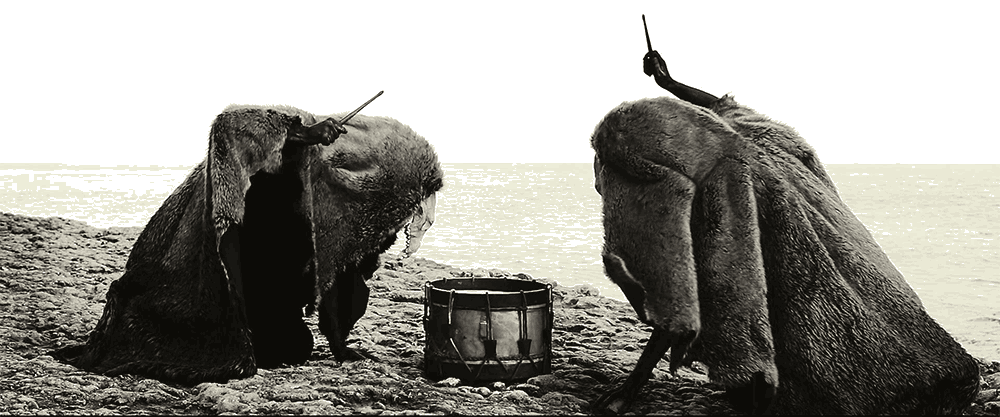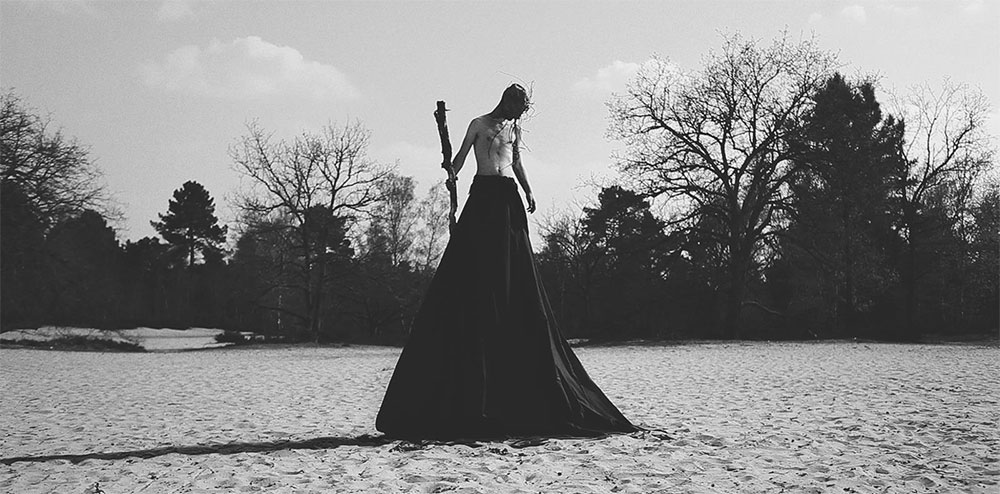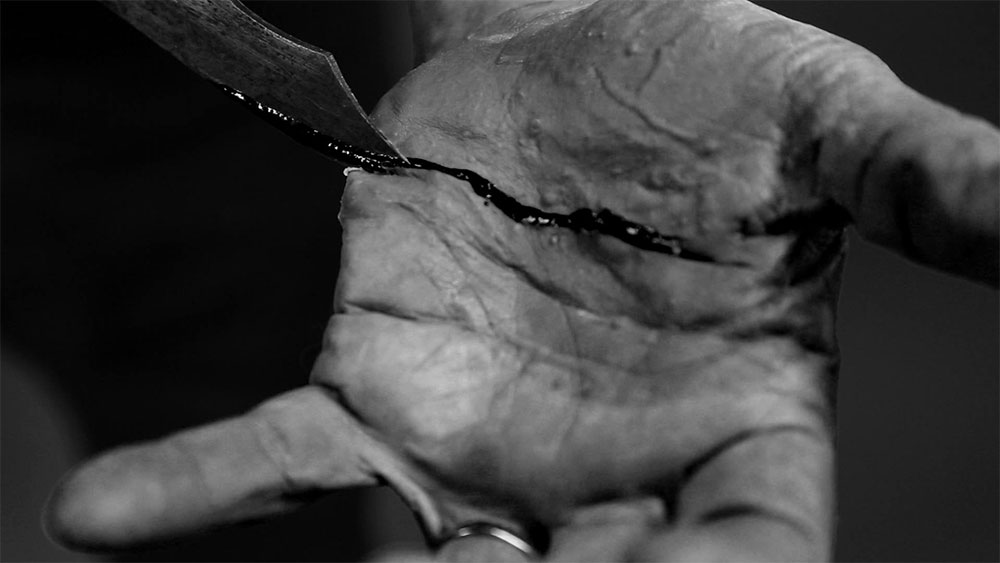Dehn Sora (Treha Sektori, Throane)
2019-11-14
by Niklas Göransson
Emotional authenticity and physical hardship as a means of creativity – a conversation with French multidisciplinary artist Dehn Sora, known from musical ventures such as dark ambient project Treha Sektori and black metal band Throane.
– For more than a decade now, I’ve been trying to capture as many modes of expression as I physically can. My main activities are usually visual in nature – graphic design, illustration, video, trying to evolve as a sculptor – but I also work with different musical approaches. I’m involved with the Church of Ra and similar collectives… or, well, I prefer the term gathering, or brethren. I’ve collaborated with many different artists with whom the common denominator has been dark and visceral manifestations. As for music, I’d say TREHA SEKTORI is my main project but THROANE rose from the same core and should be at an equal level. TREHA SEKTORI is more meditative; an exercise in attaining higher states and a cracked breath to feel appeasement amidst tumult. THROANE is bare fists ready to face swords.
TREHA SEKTORI is usually categorised as dark ambient, which might be the closest established musical genre but still doesn’t quite encompass all aspects. THROANE, on the other hand, is bleak and nihilistic black metal. The former began in 2009 and is narrated through an improvised language of Dehn Sora’s own design, whereas the latter was first heard from in 2016 and features exclusively French oration.
– Before THROANE came into existence, I never had any intention of forming this kind of music project; it could just as likely have been an extension of TREHA SEKTORI or even one of the albums. The main aspects separating the two is their language as well as underlying intention. Let’s say THROANE is a more down-to-earth version of my general vision, connected to certain primal energies which appeal to specific emotions within me. The drive to form such a musical outlet came out of an anger like I’ve never felt before, it was a blood appeal in the sense that I decided I’d rather bleed into those tracks, writing intuitively and fully immersing myself, than going out and doing something stupid. I just let it go, as a matter of balance. THROANE is something totally feral and instinctive that needs to live with its imperfections – if I start overthinking single structures or riffs, the process deviates from its stated intention. It’s also a solitary venture, despite having a live line-up consisting of close friends with a personal history connected to the project. For example, one of my live guitarists is the son of the man photographed on the debut album’s cover.

Nine months have passed since “The Sense of Dust and Sheer”, the latest TREHA SEKTORI album – what is the project’s current status?
– There are many ideas emerging inside me, I just need to find the right time and shape through which to let them out. Right now, I’m focused on a full-length video that could actually be regarded as the future album. I’m writing differently for this one, shaping images before the sounds, working after a clear vision and allowing the music to be guided by instinctive feelings. Due to my lack of skills, and since I’m doing everything by myself, the process is painfully slow but I’m also constantly learning and improving. This approach stems from my will to rethink the album format in itself. I might not even release any more physical records, despite still feeling greatly attached them – seeing one’s artistic work take material form can bring a sense of closure. But I’ve started feeling as if TREHA SEKTORIA has arrived at the end of a cycle, and this is the process I find myself gravitating towards. I’m waiting for that moment when I know it’s the next step; I must devote some time to trying out new things, experimenting more and more, in order to feel the next direction imposing itself.
Sora refers to his new compositional concept as Rejet and has been working with it since 2017. At this year’s edition of Roadburn Festival, back in April, TREHA SEKTORI performed a full set based exclusively on such material.
– I want each performance to be fully unique with entirely different energies and tensions, bringing more interventions for the senses. Being on stage is something I’m getting increasingly comfortable with but the more at ease I feel, the more detached I get from the original anxiety that facing people in a live situation would give me. I want to reconnect with the same fear as in my very first steps, so this fright can be physically sensed again. Lately, I’ve mostly felt exhaustion, anger, or something else which needs to be released. But this fear – that confrontation with the crowd – brought me elsewhere, a state of mind I could never find the right words to describe. I feel the need to push again a thousand times over. For TREHA SEKTORI, my body needs to be pushed past its boundaries; to break. When I create videos, when I write, I’m wearing myself down more and more. I almost died on several film shootings.
Almost died, really?
– Yes, some conditions were tough and I put my body in danger several times. One example: when filming the trailer for our 2014 Church of Ra tour, I sat immerged in a cold-water pool. It was wintertime and the shoot took quite a long time, so the water felt colder and colder. At a certain point I could no longer feel my body, I collapsed and had the sense that I was ‘leaving’. It took me several days to regain sensations through my fingers, and my heartbeat was irregular for weeks afterwards. I also once filmed a video under some cliffs – after being stuck in-between two places by the incoming tide, rocks started falling down over us but we managed to find a safe place in the very last moment.

TREHA SEKTORI was an unexpected personal highlight of the 2019 edition of Iceland’s Ascension festival. My preferred consumption of ambient music is in a secluded setting rather than public concerts, especially festivals, but the intestinally reverberating sonic power merging with spellbinding visuals were quite enough to make me forget being surrounded by people.
– Essentially, I want to be a shadow on stage; passing energy rather than someone whose performance you witness. Video has proven efficient in attaining this shadow-vision, as it kinda hides me and allows for emphasis on the music. The videos on the backdrop are edited after the beats and pulsate in flashes, whereas my movements should accompany the rhythms and breathing. Some clips are small parts of a larger picture – I tend to think of them as testimonies from past experiences of altered states. I feel my back breaking at every show; my legs keep shaking and I must make a conscious effort not to fall. As I said, the body needs to be fully involved in the project at all times. Unfortunately, I have to use electronic instruments but, when they need to be played, I hit them as hard as I feel like. The performance demands challenging aspects, so everything needs to be felt to one hundred percent.
All videos featured in his live performances are created from scratch. I imagine it must be bloody convenient to master such as wide range of artistic expressions when tasked to enhance a solo electronics performance.
– To be honest, I don’t feel as if I master any of the aspects, I just try my best. I don’t have much confidence in myself but, strangely, I’m not afraid of failing when working towards what drives me. I’d much rather suffer defeat than not even try. I always have a strong picture of what I want to convey, live-wise, and it would be hard to express such intensely personal sentiments through video material created by others. I hope to keep improving in this aspect, I want to push all facets of my live performances further. Back in late March, I tried out a new concept; while I was on stage, two figures were performing slow movements and covering themselves with dirt. One of them wore a black cloth wrapped around his legs to make him look and feel taller. The energy this gave me on stage was tangible and unique.

In your estimation, how much of your creative output can be attributed to sheer talent, as opposed to what you learned in art school?
– Most of my techniques are self-taught, the only classes I ever attended were during my two years of multimedia design school. I can’t really claim to have much natural talent and don’t feel particularly good at any creative discipline but – as with my live performances – I try to fully devote myself to whatever I’m doing. I’ve always felt like an outsider and have this constant anguish of not being able to learn everything I can before passing. It’s a source of daily frustration, yet I know full well that many techniques can take an entire lifetime to perfect.
If nothing else, he adds, his two years of formal education gave him a better understanding of how to structure ideas.
– School gave me the keys to reflect on my professional life, I now work as an Art Director at a Paris-based video mapping agency. I learned how to distinguish an artistic vision from a design meant for ’problem-solving’; it also socialised me a little more and gave me many reality principles. However, I was never taught about upholding the necessary distance – to not put my heart into everything, including design projects which might not necessarily need a work of art as much as a ’graphic answer’. Lately, certain feelings of social overdoses I used to suppress after those years at school have been gradually returning. The personal interaction is essential, but all the talking is sometimes too much. I prefer action, placing my hands in the charcoal, rather than just talking about a single idea.
Despite his somewhat introverted inclination, Sora has worked with a great many prolific musicians from various genres – a few examples being BLUT AUS NORD, DEATHSPELL OMEGA, AMENRA, Jarboe, TERRA TENEBROSA, MISÞYRMING, ANTAEUS, MANES, ULVER, Nordvargr, <CODE>, EPHEL DUATH, and Karyn Crisis.
– Such collaborations often happen either by way of direct contact with the band, through mutual connections, or their labels. I’m fortunate enough to have been propositioned by many artists I respect and who’ve been important to my personal history. That’s always a source of added pressure when working on what will become an immortal aspect of the band’s history. It’s also happened that I’ve approached artists I felt called to work with – in a naïve but confronting way of introducing myself, I sent them a few prints of my art. This has led to bigger long-time collaborations, which is what I’m looking for when connecting with bands; not simply being employed as another art commission waiting to be fulfilled but acting as the hands and eyes they need as their careers progress.
As is obvious from his resumé, Sora is comfortable working with musicians regardless of activity sphere; he says it’s not the artistic profile that’s important, but rather their spirit.
– Recently, I first felt very cold on working with some people. Talking only over email, I wasn’t feeling it. But when we locked eyes and shook hands for the first time, it clicked after only an hour of discussion. When I sense that someone is ready to burn for their art, I’m honoured to be a tiny part by managing aspects they can’t take care of by themselves. But it doesn’t always pan out, I failed with a band that’s one of my, let’s say, personal heroes. I was introduced to an artist connected to them and a project surfaced quickly… but, even after five or six attempts, none of the designs I came up with fitted their feelings – feelings they couldn’t put words to.
Only three visual artists, Dehn Sora included, have ever been invited to work with DEATHSPELL OMEGA. He must be doing something right, since one member of the band referred to him as ’one of the most talented artists of his generation’.
– I’m not validating the member’s assessment but I’m truly honoured by the compliment. DEATHSPELL OMEGA have such a strong vision that I felt our collaboration needed to be addressed on a larger scale. We discuss and correspond about different aspects – exchanges which can serve as the key leading to the right point. To fully understand all their lyrical references and overall message, there’s an extended absorption process which requires more than a few written lines. I pour a lot of myself into it, all the while bearing in mind that the final result has been envisioned by multiple eyes. It’s like being handed a precious fire you must keep burning, feeding the flames while holding it in your hands. For example, there were challenges of every scale around the “Ad Arma! Ad Arma!” video. One such was the change of direction into aesthetic realms which aren’t my usual path. The band gave me inputs, a guide, but I think the original shape they expected changed when the physical work began.
I noticed in the aforementioned video a familiar motif; the hand coming out of the ground would, at least in concept, appear to be rather similar to the cover artwork Sora created for SEKTARISM’s “Fils de Dieu”.
– It might connect to an unconscious vision but the hand symbol has entirely different meanings for the respective project. You could probably also mention a video I made for THROANE’s live performances, it shows a man practising an oath rite by, slowly and with great determination, opening the palm of his hand with a knife. We can scry in our palm lines, the hand gives and the hand takes back – it’s both an energy centre and a terrible weapon. Symbols sometimes speak different languages; the meaning in the “Ad Arma!” video is that the same hand which creates can also crush everything instantaneously, whereas the “Fils de Dieu” cover was a revelation given to a faceless entity. In order to increase these sensations, both of them were given a distorted scale.
Which reminds me – I know next to nothing about surrealist art but was told to inquire about Sora’s possible relationship to Italian sculptor Giuseppe Penone and his Elevazione installation. I’m assuming the recommendation to be related to their common themes of precisely this type of reality distortion.
– I actually didn’t know about Penone‘s installation until very recently but, based on photos I’ve seen, I certainly recognise a connection between our works; reality is distorted but still kept palpable, something that could very well happen. This principle drives me a lot. I must say, though, I also lack real knowledge of surrealist arts. Actually, some movies relating to surrealism have moved me far more than any painting ever did. Seen in a larger scale, I think of Shinya Tsukamoto‘s Tetsuo – this film had a major impact on the younger me. Also Lubo Kristek‘s sculptures, for example, trying to inject that notion of it possibly being a testimony of real lived experience. What might look distorted was forged with the strong conviction of it being actual reality.

I read with interest about the instinctive language Sora uses for TREHA SEKTORI. He’s previously stated that he took it up in childhood which, in turn, reminded me of Lisa Gerrard. The Australian DEAD CAN DANCE vocalist developed her own singing language at twelve years of age, believing it to provide a direct line of communication with God. I suspect this might not have been the case here.
– I never perceived it as a link to any kind of divinity, more of a connection with another plane of existence; an after-life, or the embracing of states beyond conscious control. But yes, it started in my childhood, as a result of not being able to express certain feelings or cope with overwhelming emotions. I’ve read that this kind of instinctive language can be developed when the mind is overcharged – it becomes a shield during moments of paralysing fear, for example. Some lexical structures in the language emerged over the years, recurring words, sonorities, as well as a way to write it. Most of my tattoos are based on this writing. In terms of typography, it doesn’t look like words on a paper or screen but more like ideograms drawn by themselves.
One example of this writing can be seen in the “Endessiah” video, where a figure is shown carving it in stone.
– I’ve used psychedelics but never on a regular basis. I’m kinda always in control but my body reacts a lot to my mind and gives me signs. TREHA SEKTORI acts as a catalyst for those experiences to happen, letting the body speak for my insides. I suppose this is the form through which my body seeks to expel thoughts, shaping them in order to understand them. This language is the key to something I feel I don’t need to understand why or when it comes – I believe it contains some kind of messages from an altered state which I get to shape in this reality.



